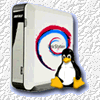Better Safe than Sorry: Backup all my data!
1. Boot up PC from Knoppix LiveCD.
2. Connect backup HDD via USB - /dev/sda1.
3. Connect LS2 HDD via USB - data is on /dev/sdb3.
4. Access sda1 and sdb3 shortcuts on desktop.
5. Open a command console.
6. Become root user - su
7. Backup data - dd if=/dev/sdb3 of=/dev/sda1
Wait for the backup to complete. Mine took 18.5 hours!
Note: Since my data was accessible, the LS2 HDD would seem to not be physically faulty.








